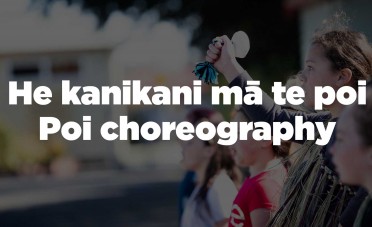He poi roa, tapatahi Single long poi
Practice and perform he poi roa, tapatahi (single long poi), and learn about the tikanga of poi.
Exploring te ao kori — Activity collections
This resource is part of a series within the Exploring te ao kori activity collections called Ngā mahi poi | Poi activities.

Intended outcomes
Ākonga:
- use poi to develop movement skills and follow simple tikanga to care for the poi
- demonstrate sharing and cooperative skills when working in group activities with poi
- create poi sequences and perform these for others
- demonstrate the use of the poi and an understanding of the whakapapa associated with the poi
- understand the use of the poi in te ao Māori
- perform poi sequences for an audience in time to music.
Video
Suggested approach
With ākonga, explore what they know about the poi. Where or when have they seen poi before, where it originated from and who uses it. What was was poi used for traditionally and why it is used today?
Show ākonga live or videoed performances of poi skills and sequences. There are examples of poi performances on the internet; have a look as part of your planning and notice where the videos have come from to ensure that you are showing ākonga authentic and relevant poi performances.
Discuss the skills required to use the poi, the patterns shown (circles, high and low), the relationship of the poi movements to the accompanying waiata or music, and the performers’ ability to perform the poi patterns in time with the music.
Read the whakapapa of the poi to ākonga. Ākonga can discuss the ways in which we care for Papatūānuku and how this could be applied to looking after a traditionally made poi.
Give ākonga a single long poi each. Ask ākonga to identify what poi are made of today.
Discuss together how ākonga would need to look after the poi, and also how they need to respect the space of others around them when using poi.
Help the class to develop tikanga (a set of guidelines) that ākonga can use for poi.
Using the single long poi, ākonga explore:
- moving the poi in response to one or more different pieces of music, for example, 'E Rere Taku Poi' or 'Ngoi Ngoi', at different levels, speeds, from different body bases
- moving the poi around the body while they are travelling in straight and curved pathways.
Ākonga practise a variety of actions with the teacher, for example:
- standing still and spinning the poi with the right hand, then the left hand, then with both hands
- walking in a small circle and swinging the poi with the right hand, with the left hand, and then with both hands
- sitting and swinging the poi with the right hand, with the left hand, and then with both hands
- lying flat on the floor or carpet and swinging the poi with the right hand, with the left hand, and then with both hands
- kneeling and swinging the poi with the right hand, with the left hand, and then with both hands
- swinging the poi in front of the body, then behind the head with the left hand, with the right hand, then with both hands
- swinging the poi across the body and to the open side at shoulder height, at waist height, with changing hands
- swinging the poi in a figure-of-eight across and to the side of the body, with one hand, with the other hand.
In pairs, ākonga experiment and vary any of the above movements and complete a sequence of four different poi actions or patterns. Challenge ākonga to include in their sequences:
- travelling movements and changes in relationships to each other, for example, mirroring, shadowing, around each other, towards and away from each other, and so on
- different levels, for example, low, medium, high
- different body bases, for example, sitting, standing, kneeling.
Two pairs demonstrate their routines to each other. Each pair can practise giving constructive feedback about the other pair's sequence, for example, that the sequence could be improved by including more variety in the use of direction facings or levels.
The pairs teach their sequence to each other and then, in a group of four, use all their actions and make a new, longer sequence.
Ākonga can be challenged to include travelling movements, changes in directions and formations in this group sequence, for example, circles, lines, rows, and to rehearse these with a backing track of music.
Ākonga perform their sequence to music for the class and tell the class the ways in which their group observed the tikanga agreed to by the class.
Help ākonga reflect on how their group worked cooperatively to share their poi actions, learn new movements, and make up sequences that can be performed in time with an appropriate backing track.
